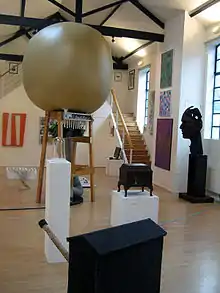The London Group
The London Group is a society based in London, England, created to offer additional exhibiting opportunities to artists besides the Royal Academy of Arts. Formed in 1913, it is one of the oldest artist-led organisations in the world. It was formed from the merger of the Camden Town Group, an all-male group, and the Fitzroy Street Group. It holds open submission exhibitions for members and guest artists.


Overview
The London Group is composed of working artists. All forms of art are represented. The group functions democratically without dogma or style.[1] It has a written constitution, annually elected officers, working committees and a selection committee. There are usually between 80 and 100 members and an annual fee is charged to cover gallery hire and organisational costs. The group has no permanent exhibition venue and rents gallery space in London, most recently at the Menier Gallery, Bankside Gallery and Cello Factory. New members are elected most years, from nominations made by current members.[1]
History
The London Group was founded in 1913, when the Camden Town Group came together with the English Vorticists and other independent artists to challenge the domination of the Royal Academy of Arts, which had become unadventurous and conservative.[2]
The London Group emerged from a merger of the Fitzroy Street Group and the male-member-only Camden Town Group organization.[1] Founding members included the patron-artist Ethel Sands, artist Anna Hope Hudson,[3] Walter Sickert, Jacob Epstein, Wyndham Lewis, Robert Bevan and his wife Stanislawa de Karlowska, and Henri Gaudier-Brzeska.[4] Other early female members included Marjorie Sherlock,[5] Mary Godwin,[6] and Ruth Doggett.[7] Throughout its history, The London Group has held open submission exhibitions to encourage and support other artists struggling to get their work shown in public. The open submissions are shown along with the work of existing members and guest artists.[5] The exhibition Uproar! celebrated the first 50 years of the London Group in 1963, and it highlighted the role played by women and emigre artists in its membership.[8] In 2013–14, the Ben Uri Gallery celebrated The London Group's 100-year anniversary with an exhibition Uproar: The First 50 Years of The London Group 1913-1963 curated by Rachel Dickson and Sarah MacDougall.[4][9]
One of the oldest standing artist-led organisations in the world, The London Group continues to exist today with over 80 members. In 2011, the open exhibition presented over 140 artists at the Cello Factory. The group celebrated its 100th anniversary in 2013 with several shows, both historical and contemporary.[1]
References
- Redfern, David (2008). The London Group: Origins and Post War History. Croydon College.
- Wilcox, Denys J. (1995). The London Group, 1913–1939: The Artists and Their Works. Scolar Press. ISBN 978-1859280485.
- Moorby, Nicola (March 2003). "Ethel Sands 1873–1962". In Bonett, Helena; Holt, Ysanne; Mundy, Jennifer (eds.). The Camden Town Group in Context. Tate Research Publication. ISBN 978-1849763851. Archived from the original on 4 March 2016. Retrieved 17 January 2016.
- MacDougall, Sarah; Dickson, Rachel, eds. (2013). Uproar!: The First 50 Years of the London Group 1913–63 (Catalog). Burlington, VT: Lund Humphries. ISBN 978-1848221444.
- Redfern, David (2013). The London Group: A History 1913–2013. The London Group. ISBN 978-1000015850.
- "Mary Godwin 1887-1960". Louise Kosman. Archived from the original on 13 April 2013. Retrieved 8 July 2018.
- "Ruth Doggett 1881-1974". Louise Kosman. Archived from the original on 28 July 2019. Retrieved 28 July 2019.
- McNay, Anna (6 January 2014). "Uproar! The First 50 Years of the London Group 1913-1963". Studio International (Exhibition review). Archived from the original on 17 February 2014.
- Darukhanawala, Percy (13 January 2014). "Uproar! The First 50 Years of the London Group: 1913-63 (Ben Uri Gallery)". The Courtauld Institute of Art. Archived from the original on 6 September 2015. Retrieved 5 October 2019.